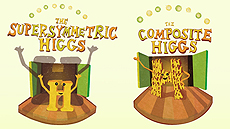One Higgs is the loneliest number
 |
Physicists discovered one type of Higgs boson in 2012. Now they're looking for more. Image: Sandbox Studio |
When physicists discovered the Higgs boson in 2012, they declared the Standard Model of particle physics complete; they had finally found the missing piece of the particle puzzle.
And yet, many questions remain about the basic components of the universe, including: Did we find the one and only type of Higgs boson? Or are there more?
A problem of mass
The Higgs mechanism gives mass to some fundamental particles, but not others. It interacts strongly with W and Z bosons, making them massive. But it does not interact with particles of light, leaving them massless.
These interactions don't just affect the mass of other particles, they also affect the mass of the Higgs. The Higgs can briefly fluctuate into virtual pairs of the particles with which it interacts.
Scientists calculate the mass of the Higgs by multiplying a huge number — related to the maximum energy for which the Standard Model applies — with a number related to those fluctuations. The second number is determined by starting with the effects of fluctuations to force-carrying particles like the W and Z bosons, and subtracting the effects of fluctuations to matter particles like quarks.
While the second number cannot be zero because the Higgs must have some mass, almost anything it adds up to, even at very small numbers, makes the mass of the Higgs gigantic.
But it isn't. It weighs about 125 billion electronvolts; it's not even the heaviest fundamental particle.
"Having the Higgs boson at 125 GeV is like putting an ice cube into a hot oven and it not melting," says Flip Tanedo, a theoretical physicist and postdoctoral researcher at the University of California, Irvine.
A lightweight Higgs, though it makes the Standard Model work, doesn't necessarily make sense for the big picture. If there are multiple Higgses — much heavier ones — the math determining their masses becomes more flexible.
"There's no reason to rule out multiple Higgs particles," says Tim Tait, a theoretical physicist and professor at UCI. "There's nothing in the theory that says there shouldn't be more than one."
The two primary theories that predict multiple Higgs particles are Supersymmetry and compositeness.
Read more
—Katie Elyce Jones
|